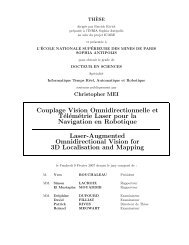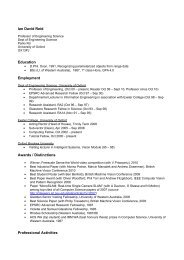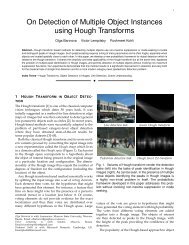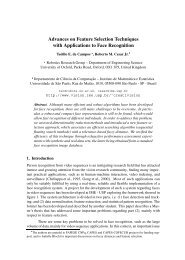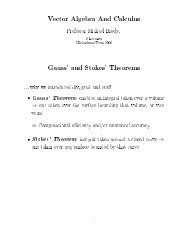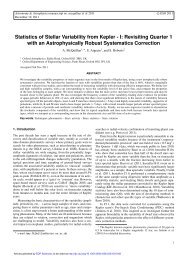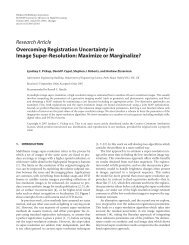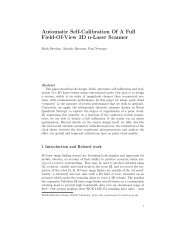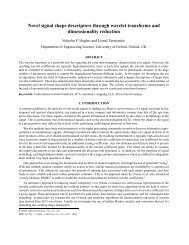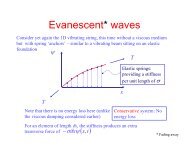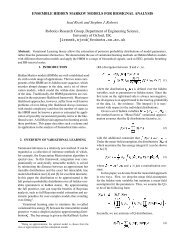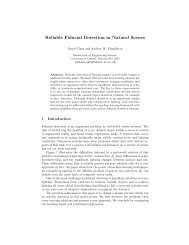Physiological Basis of the Electrocardiogram
Physiological Basis of the Electrocardiogram
Physiological Basis of the Electrocardiogram
You also want an ePaper? Increase the reach of your titles
YUMPU automatically turns print PDFs into web optimized ePapers that Google loves.
1.1 Cellular Processes That Underlie <strong>the</strong> ECG 3<br />
decrease in calcium conductivity which also contributes to cellular repolarization.<br />
Phase 4, <strong>the</strong> resting condition, is characterized by open potassium channels and <strong>the</strong><br />
negative transmembrane potential. After phase 0, <strong>the</strong>re are a parallel set <strong>of</strong> cellular<br />
and molecular processes known as excitation-contraction coupling: <strong>the</strong> cell’s depolarization<br />
leads to high intracellular calcium concentrations, which in turn unlocks<br />
<strong>the</strong> energy-dependent contraction apparatus <strong>of</strong> <strong>the</strong> cell (through a conformational<br />
change <strong>of</strong> <strong>the</strong> troponin protein complex).<br />
Before <strong>the</strong> action potential is propagated, it must be initiated by pacemakers,<br />
cardiac cells that possess <strong>the</strong> property <strong>of</strong> automaticity. That is, <strong>the</strong>y have <strong>the</strong> ability<br />
to spontaneously depolarize, and so function as pacemaker cells for <strong>the</strong> rest <strong>of</strong> <strong>the</strong><br />
heart. Such cells are found in <strong>the</strong> sino-atrial node (SA node), in <strong>the</strong> atrio-ventricular<br />
node (AV node) and in certain specialized conduction systems within <strong>the</strong> atria and<br />
ventricles. 3 In automatic cells, <strong>the</strong> resting (phase 4) potential is not stable, but shows<br />
spontaneous depolarization: its transmembrane potential slowly increases toward<br />
zero due to a trickle <strong>of</strong> sodium and calcium ions entering through <strong>the</strong> pacemaker<br />
cell’s specialized ion channels. When <strong>the</strong> cell’s potential reaches a threshold level,<br />
<strong>the</strong> cell develops an action potential, similar to <strong>the</strong> phase 0 described above, but<br />
mediated by calcium exchange at a much slower rate. Following <strong>the</strong> action potential,<br />
<strong>the</strong> membrane potential returns to <strong>the</strong> resting level and <strong>the</strong> cycle repeats. There are<br />
graded levels <strong>of</strong> automaticity in <strong>the</strong> heart. The intrinsic rate <strong>of</strong> <strong>the</strong> SA node is<br />
highest (about 60 to 100 beats per minute), followed by <strong>the</strong> AV node (about 40 to<br />
50 beats per minute), <strong>the</strong>n <strong>the</strong> ventricular muscle (about 20 to 40 beats per minute).<br />
Under normal operating conditions, <strong>the</strong> SA node determines heart rate, <strong>the</strong> lower<br />
pacemakers being reset during each cardiac cycle. However, in some pathologic<br />
circumstances, <strong>the</strong> rate <strong>of</strong> lower pacemakers can exceed that <strong>of</strong> <strong>the</strong> SA node, and<br />
<strong>the</strong>n <strong>the</strong> lower pacemakers determine overall heart rate. 4<br />
An action potential, once initiated in a cardiac cell, will propagate along <strong>the</strong><br />
cell membrane until <strong>the</strong> entire cell is depolarized. Myocardial cells have <strong>the</strong> unique<br />
property <strong>of</strong> transmitting action potentials from one cell to adjacent cells by means <strong>of</strong><br />
direct current spread (without electrochemical synapses). In fact, until about 1954<br />
<strong>the</strong>re was almost general agreement that <strong>the</strong> myocardium was an actual syncytium<br />
without separate cell boundaries. But <strong>the</strong> electron microscope identified definite cell<br />
membranes, showing that adjacent cells separate. They are tightly coupled, however,<br />
to transmit both tension and electric current from cell to cell. The low-resistance<br />
connections are known as gap junctions. Ionic currents flow from cell to cell via<br />
<strong>the</strong>se intercellular connections, and <strong>the</strong> heart behaves electrically as a functional syncytium.<br />
Thus, an impulse originating anywhere in <strong>the</strong> myocardium will propagate<br />
throughout <strong>the</strong> heart, resulting in a coordinated mechanical contraction. An artificial<br />
cardiac pacemaker, for example, introduces depolarizing electrical impulses via<br />
an electrode ca<strong>the</strong>ter usually placed within <strong>the</strong> right ventricle. Pacemaker-induced<br />
action potentials excite <strong>the</strong> entire ventricular myocardium resulting in effective<br />
mechanical contractions.<br />
3. This is true for normal operating conditions. In pathological conditions, any myocardial cell may act as a<br />
pacemaker.<br />
4. Pacemakers o<strong>the</strong>r than <strong>the</strong> SA node may also take over <strong>the</strong> regulation <strong>of</strong> <strong>the</strong> heart rate when faster pacemakers<br />
are not effective, such as during episodes <strong>of</strong> AV block; see Section 1.3.3.



